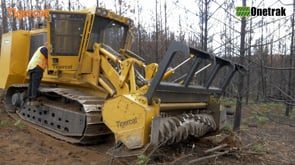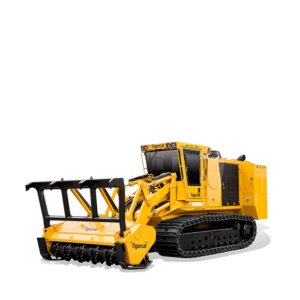– Glen Marley, Tigercat district manager Australia and New Zealand
After the summer that Australia had, bushfire prevention is surely on the minds of many people. Last September, previous to the carnage, Tigercat and Australian dealer Onetrak were asked by the Forestry Corporation of NSW to assist in preparing and mulching a trial site in a very unique forest. The majestic Sugar Pine Walk at Laurel Hill in the Bago State Forest, with its towering trees and pine-needle carpeted floor, has for many years been an iconic natural and historic site in the Riverina-Tumbarumba region at the western edge of the Snowy Mountains.
In response to the request, Tigercat and Onetrak provided a 480B mulcher to Forestry Corporation for the duration of the land preparation work. “Onetrak, our local team in Tumut and Tigercat are happy to be able to support the local forestry industry and this important community project,” says Onetrak managing director, David Hazell. “Our close relationship with Tigercat and their full factory support helps make these activities possible.”
The Tigercat 480B mulcher was launched in Australia in May 2019. In addition to stump grinding and vegetation mulching, its uses include clearing regrowth, right-of-way clearing for powerlines, land divisions and fuel hazard reduction operations.
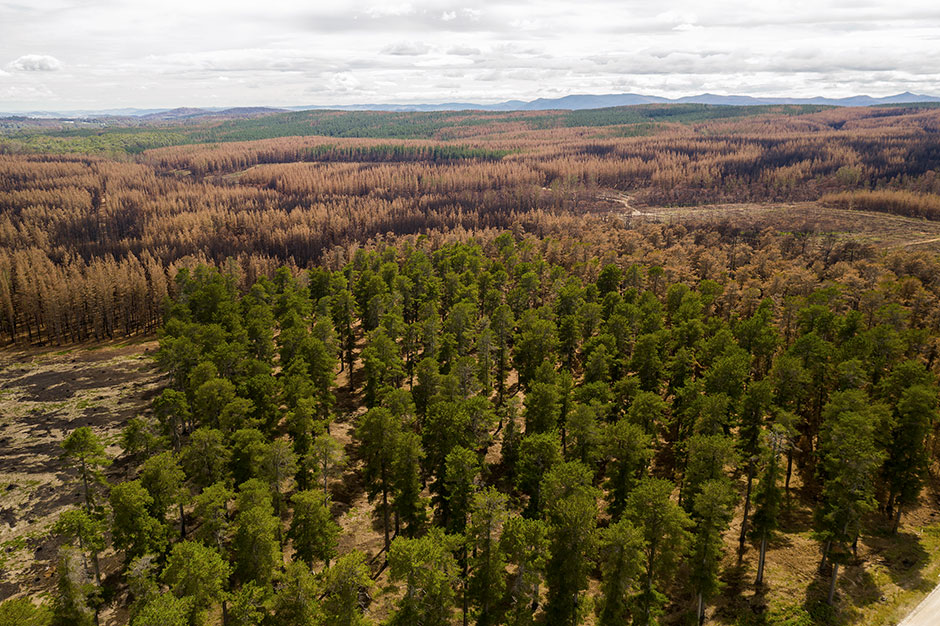
Planted in 1928, the enormous sugar pines provided a short, easy stroll among some of the tallest and largest pines in the world. The Forestry Corporation of NSW recently commenced a succession project to ensure that the unique experience is preserved for future generations. The objective of the project is to create a shared space with the local community – people who are heavily invested in forestry and whose townships depend upon the industry.
The site preparation portion of the trial was part of the overall Sugar Pine Walk succession plan. Along with the site preparation mulching operation, the Forestry Corporation team also asked for some younger wildling pines and invasive plant species to be cleared from underneath a neighbouring pine stand, planted in 1922. This second component of the mulcher trial would provide a fire hazard ground fuel reduction trial and replicate a fire break buffer zone.
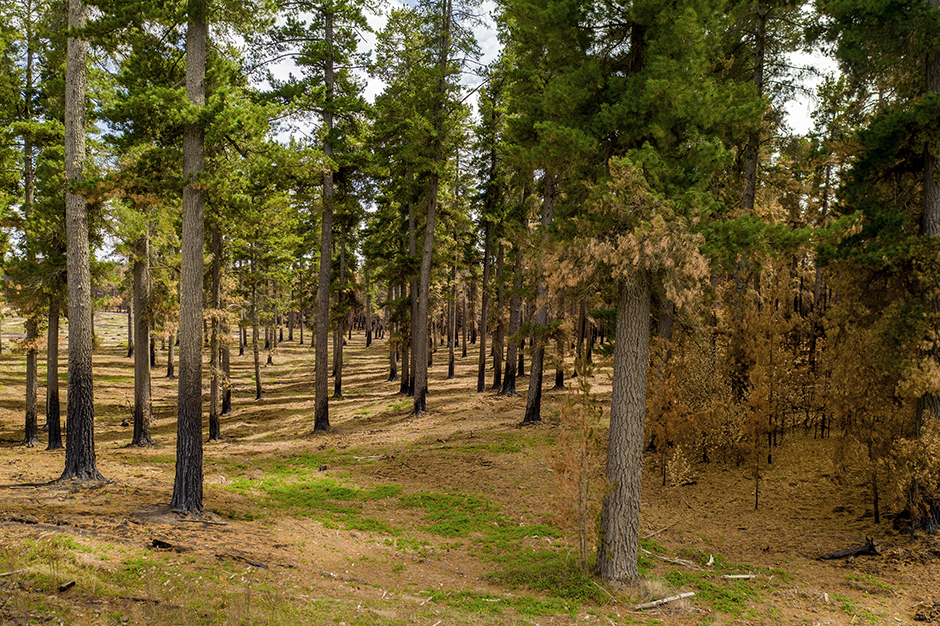
The healthy stand in the foreground was treated prior to the bushfires. The area beneath the trees was mulched, effectively removing deadwood, wildling pines and invasive plant species. All of the surrounding untreated areas including the Sugar Pine Walk itself were unable to withstand the fires.
The original idea was to grow a new forest that would eventually replace the current Sugar Pine Walk as it aged over the next century. A suitable replacement site was selected and so far, five hectares have been harvested. “The trees removed from the new site are from a 1922 Pinus Radiata plantation. Hence there are large post-harvesting stumps and debris remaining,” says Forestry Corporation harvesting supervisor, Elle Kromar. “Thanks to Onetrak and Tigercat, we have been fortunate to have access to a Tigercat 480B mulcher, which has spent a week grooming the site and chewing debris into mulch.”
“This project is a great opportunity to demonstrate the new machine and its suitability for forestry applications and local conditions,” says Onetrak territory manager, Phil Turnbull. “The before and after photos of the site speak for themselves and we are very happy with the mulcher’s performance.”
Then on December 28, just a few months after the initial trial, this same region was devastated by the massive 2020 bushfires. Started by a lightning strike, a local fire burned through the area, merged with a second fire and went on to engulf some 600 000 ha (1,500,000 acres), including over 52 000 ha (130,000 acres) of commercial Radiata pine. Sadly, the Sugar Pine Walk was severely damaged and is now closed to the public. How did the adjacent pine stand fare?
With approximately half the Radiata pine stand recently mulched and cleared of brush and fuelwood with the 480B, the results are all too clear. Today, the trees growing in the cleared area are virtually untouched and remain healthy. The trees growing in the untreated areas have been decimated and did not survive the intensified heat during the catastrophic fires.
THE TREES GROWING IN THE CLEARED AREA ARE VIRTUALLY UNTOUCHED AND REMAIN HEALTHY. THE TREES GROWING IN THE UNTREATED AREA HAVE BEEN DECIMATED AND SADLY DID NOT SURVIVE THE INTENSIFIED HEAT DURING THE CATASTROPHIC FIRES.
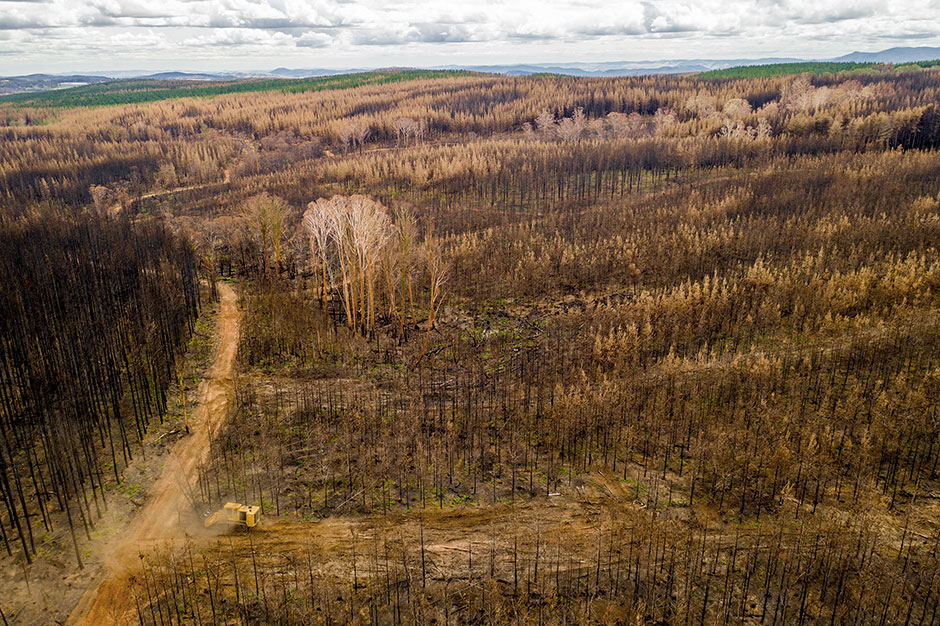
The 480B mulcher efficiently clearing unsalvageable burnt timber after the fires, in preparation for replanting.
Now, with tens of thousands of hectares of burnt Radiata pine plantations in the region, quick, efficient, and ecologically responsible ground preparation and replanting is essential. To that end, the 480B returned to the area in February to begin the process of mulching the unmerchantable burn wood and debris in preparation for replanting.
Where the salvage value of the burnt trees is negligible, mulching is a very cost-effective solution in young and medium-sized stands. Particularly in areas that have been contour planted, mulching will greatly assist in the reduction of ground disturbance, compaction and erosion. The remaining residue ground cover has the added advantage of retaining higher moisture levels in the subsoil – critical in drought conditions.
Replanting seedlings directly after mulching may be achievable without traditional windrowing and deep ripping operations, helping to reduce the cost of re-establishing plantations.
Tigercat mulcher carriers offer excellent build quality, efficient hydraulic systems, a comfortable, ergonomic operator’s station, and easy access to components and daily service points. The result is high uptime and productivity – essential in time-sensitive fire hazard fuel load reduction and right-of-way clearing projects.
The 480B mulcher is built for the toughest terrain, soft soil conditions and the most demanding duty cycles. With a power rating of 411 kW (550 hp), the Tigercat FPT C13 engine offers quick load response, low operating costs and high power density, combined with excellent fuel economy.
Tigercat and Onetrak can play a vital role in the bushfire recovery efforts now faced by Forestry Corporation. The outstanding trial results have proven the Tigercat 480B to be an essential tool in hazard reduction and defending plantations against the threat of future bushfires.

Click the link below to watch the associated video on Tigercat TV.






